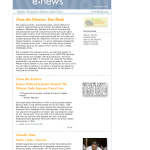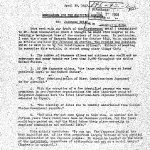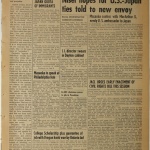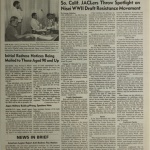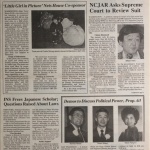Charles Fahy
| Name | Charles Fahy |
|---|---|
| Born | August 17 1892 |
| Died | September 17 1979 |
| Birth Location | Rome, Georgia |
Wartime solicitor general who argued the four Japanese American cases before the U.S. Supreme Court in 1943–44. His suppression of key evidence in the cases from the Supreme Court led to the revisiting of the cases in the 1980s.
Charles Fahy (1892–1979) was born in Rome, Georgia, to Thomas and Sarah Jonas Fahy. Attending local schools, he graduated from the University of Notre Dame in 1911 and Georgetown Law School in 1914, after which he passed the D.C. bar and entered into private practice. During World War I, he became a naval aviator and was awarded the Navy Cross. In 1924, he moved with his family to Santa Fe, New Mexico, for health reasons and continued his practice. He returned to Washington in 1933 to take a post as assistant solicitor to the Department of Interior. From 1935 to 1940, he served as the first general counsel to the newly formed National Labor Relations Board, in which capacity he appeared frequently before the Supreme Court. He was appointed assistant solicitor general in 1940, and on November 1, 1941, he was named solicitor general, succeeding Francis Biddle , who was appointed attorney general.
As solicitor general, Fahy was responsible for preparing and arguing all cases involving the U.S. government before the Supreme Court. These include the four Japanese American cases heard by the Supreme Court, and he personally argued all four. He was also a key figure in the behind-the-scenes drama in the Justice Department concerning how the cases would be argued. In preparing for the Hirabayashi and Yasui cases, Assistant Attorney General Edward Ennis obtained a copy of a report by Kenneth Ringle of the Office of Naval Intelligence that recommended a limited internment of Japanese Americans, which seemed to undercut the argument of General John DeWitt that individual determinations of loyalty could not be made. Ennis wrote to Fahy that they needed to let the court know of the Ringle report, arguing "It occurs to me that any other course of conduct might approximate the suppression of evidence." [1] The Hirabayashi brief ignored issues raised by Ennis and Ringle, and Fahy did not alert the Supreme Court as to the existence of Ringle's report. Fahy successfully argued the government's side in the Hirabayashi and Yasui cases, and the Supreme Court upheld their convictions of violating the curfew.
In preparation for the Korematsu case, Ennis's aide John Burling informed Fahy about reports by the FBI and Federal Communications Commission (FCC) that refuted General John DeWitt 's claims of offshore signaling by Japanese Americans that were a lynchpin in his argument for mass exclusion. In preparing the government's Korematsu brief for Fahy, Burling inserted a footnote disavowing DeWitt's claims about the signaling, noting the existence of contrary evidence. Caught between Burling and Ennis on the one hand, who wanted to let the Court know about the issues behind DeWitt's claims even if it substantially weakened the government's case. and by War Department and army officials whom he viewed as his client on the other, Fahy waffled, ultimately deciding on a vague footnote that made no specific mention of the contrary evidence. He successfully argued the Korematsu case, with the Supreme Court again upholding the conviction. [2] He also argued the Endo case, which the Supreme Court decided in Endo's favor, effectively ending the mass incarceration.
Fahy resigned as solicitor general in July 1945. He spent the next year in Germany as director of the legal division of the U.S. Group Control Council in Germany and another year as a legal advisor for the State Department. During this period, he was also involved in the formation of the United Nations. He briefly returned to private practice in 1947 before being appointed as a judge on the U.S. Court of Appeals for the D.C. circuit in 1949. [3] Legal historian Peter Irons writes that he "gained repute as a judicial liberal" who often ruled against the government in McCarthy era civil liberties cases. [4] He became a senior judge in 1967, remaining one until his passing in 1979.
In the 1980s, Irons and researcher and activist Aiko Herzig-Yoshinaga discovered the documents that revealed the suppression of evidence by Fahy and others before the Supreme Court. This evidence became the key to the coram nobis cases that ultimately resulted in the vacating of the convictions of Hirabayashi, Yasui, and Korematsu. In 2011, one of Fahy's successors, Neal Katyal, publicly acknowledged Fahy's misconduct in the Japanese American cases, noting that Fahy had a "duty of absolute candor in our representations to the court," adding, "It seemed obvious to me we had made a mistake. The duty of candor wasn't met." [5]
For More Information
"Charles Fahy, Twenty-Sixth Solicitor General, November 1941 -September 1945." Solicitors General 1870 - Present, Office of the Solicitor General, United States Department of Justice. http://www.justice.gov/osg/aboutosg/osghistpage.php?id=25 .
Irons, Peter. Justice at War: The Story of the Japanese American Internment Cases . New York: Oxford University Press, 1983. Berkeley: University of California Press, 1993.
Muller, Eric. "Hirabayashi: The Biggest Lie of the Greatest Generation." UNC Legal Studies Research Paper No. 1233682, 2008. < http://papers.ssrn.com/sol3/papers.cfm?abstract_id=1233682## >.
"Papers of Charles Fahy, 1933–1957." FDR Presidential LIbrary and Museum. http://www.fdrlibrary.marist.edu/archives/pdfs/findingaids/findingaid_cfahy.pdf .
Footnotes
- ↑ Peter Irons, Justice at War: The Story of the Japanese American Internment Cases (Berkeley: University of California Press, 1993), 204.
- ↑ Fahy's outline for his oral argument in the Korematsu case included quotations from DeWitt's Final Report about signaling and radio transmission that he knew to be false as demonstrated by the FBI and FCC reports. It is unkonwn if he actually cited these in his oral argument, since there is no surviving transcript. See Irons, Justice at War , p. 317.
- ↑ Pacific Citizen , Oct. 22, 1949, 8.
- ↑ Irons, Justice at War , 356–57.
- ↑ David G. Savage, "U.S. Official Cites Misconduct in Japanese American Internment Cases," Los Angeles Times , May 24, 2011, accessed on October 1, 2013 at http://articles.latimes.com/2011/may/24/nation/la-na-japanese-americans-20110525 .
Last updated July 15, 2020, 3:27 p.m..

